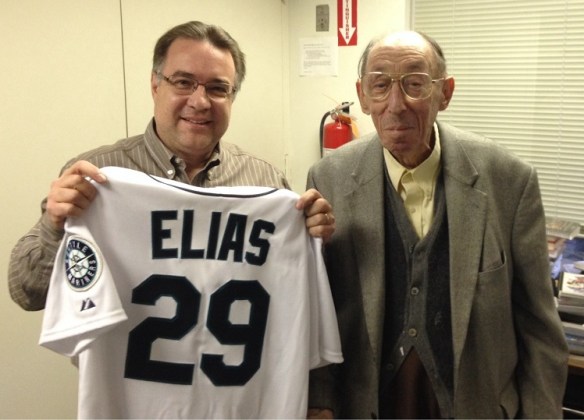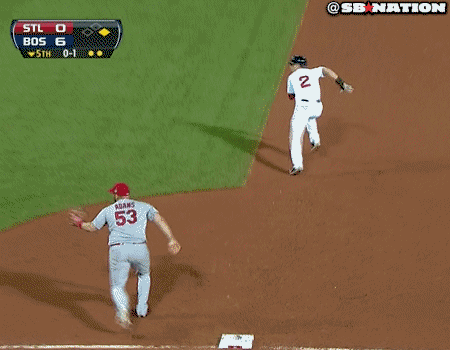
Seymour Siwoff (right) with the Elias Sports Bureau’s John Labombarda in 2014, after a Mariners blog presented them with a jersey worn by a Mariner unrelated to the statistical family. (Yes, you could look it up, below.)
As James Thurber’s Squawks Magrew once said in naming a charming 1941 short story (and as Casey Stengel loved to say regardless), “You Could Look It Up.” As the longtime owner and president of the Elias Sports Bureau, Seymour Siwoff loved to insist, “Look it up anyway. Don’t trust your memory.”
Siwoff, who died Friday at 99, the same number of years as runs driven in by Hall of Famer Eddie Murray in his third major league season, once resembled a slender and balding Walt Disney wearing Groucho Marx’s mustache. He also earned a Purple Heart in the World War II infantry, which ought to tell you how much actual Mickey Mouse recessed within him.
And he was one of the three men (Branch Rickey and his find Allan Roth were the others, arguably) who seeded the garden of change in the way baseball and other sports’ fans and professionals analyse their games. The National League began something marvelous when naming Elias its official statistician in the 1950s.
“I thought I’d try it for a while,” said Siwoff, who actually once considered joining the Internal Revenue Service, lucky for us that he didn’t, about joining Elias in the first place, “and I wound up trying it for a lifetime.”
Today the bureau does that job for all major league baseball and five other professional sports leagues. As Stengel would also say, they’ve been rather splendid in their line of work, which tells you something about the man who first joined the bureau—while a high school student—two decades after its 1916 founding in New York by brothers Al Munro Elias and Walter Elias.
And, at a time when meeting its payroll was about as simple as sneaking one past a healthy Lou Gehrig. Siwoff himself once endured a streak without weekly paychecks the way Original Mets pitcher Roger Craig endured a 1963 streak of being charged with eighteen consecutive losses, tying Clifton Curtis’s National League record. “Happily,” wrote Sports Illustrated‘s Jerry Kirshenbaum in a 1969 profile, “Siwoff has come to know better times.”
Although he still works at the same place that used to have trouble paying its help, he does so as the boss rather than as an employee. And he has become, as it was his heartfelt mission to become, the sports world’s No. 1 professional answer man. Although primarily a statistician, Siwoff traffics not only in the bare bones of figures and fractions but also in that somewhat fleshier matter that is sometimes called, redolent of a quainter day, dope. “My job isn’t just figuring out batting averages,” he says with an uneasy grandiloquence. “I’m in the business of problem solving, you might call it. I suppose you might even say that I’m running a think factory.”
Siwoff’s Elias developed a penchant for finding diamonds while mining for mere rubies. Kirshenbaum mulcted a typical such find: tasked by writers in the Wrigley Field press box for something in particular about Ernie Banks, Siwoff’s bloodhounds unearthed the knowledge that Banks’s fellow Hall of Famer Willie Mays actually played a game at . . . shortstop, Banks’s own original position. (Turns out Mays played two games at short lifetime. Yes, you could look it up.)
“It’s unbelievable the things you come across just leafing through these sheets,” Siwoff told Kirshenbaum. Siwoff then had four full-time employees working in a room the entrance to which featured a sign above: “Eternal vigilance is the price of accuracy in statistics.”
Kirshenbaum didn’t provide the date, but on 13 May 1969 the Wrigley pressmen wanted to know any previous time Banks drove seven runs in in a game. (He’d just done it against the infant Padres with an RBI double and a pair of three-run homers.) Siwoff’s hounds exhumed two previous such occasions: 4 August 1955 (against the Pirates) and 1 May 1963 (against the Cardinals).
“This intelligence went out immediately over the ball park’s public-address system to the crowd on hand and, via the press box, to the outside world,” Kirshenbaum wrote. “‘If Seymour says it’s so, then it’s so,’ testified Chuck Shriver, the Cubs’ publicity man. ‘He’s my bible’.”
During the 1980s and 1990s, the annual Elias Baseball Analyst was maybe not my full baseball Bible but at least the book of Leviticus. (Bill James’s annual Baseball Abstracts were my Numbers.) From which I discovered such wonderful things to know as which hitter loved or hated to face which pitcher based on the cumulative numbers and vice versa.
“[T]he good news is that our can-do country has gone and done it,” wrote George F. Will about the Analyst in 1985. “It has produced a baseball book that almost contains all the information citizens ought to be required to master before being allowed to vote.”
Do you have a Gibbonesque fascination with declines and falls? The book reveals that the 1984 White Sox were only the eighth team in fifty years to suffer a decline of 150 percentage points in their won-lost record compared with the preceding season. In 1984 Cleveland extended to twenty-four its record for the most consecutive seasons (excluding the 1981 strike season) finishing more than fourteen games behind the league or division leader. Before the 1984 Milwaukee Brewers did it, the last team to go in just two years from the best record in the league to the worst was during the Johnson administration. The time before that, Woodrow Wilson was in his first term.
For the records: the ’84 White Sox suffered that collapse the year after they won the American League West; before the ’84 Brewers that collapse was suffered by the 1966 Yankees; before them, it was the 1914 Philadelphia Athletics, after two straight seasons with the American League’s best record. And you could look it up.
Those were the days before the Internet and the resources of Baseball Reference and retrosheet.org, who are called fairly the grandchildren of Siwoff, Rickey, and Roth. The days when an ordinary baseball fan’s deepest commercially available statistical abstract was the Reader’s Digest-sized Who’s Who in Baseball.
Elias wasn’t above puckishness, either: its Analyst for the 1987 season noted overly self-critical Red Sox reliever Calvin Schiraldi most hated to face effervescent Hall of Fame Mets catcher Gary Carter with two outs. Though all things considered I might have said “Ray Knight with deuces wild.” (Two strikes, two outs, two on. If you have to ask, you could look it up.)
The days about which Kirshenbaum could write and get away with saying, “In encouraging the proliferation of statistics, Siwoff has had the good sense to realize that they are valuable only insofar as they reflect what happened in yesterday’s game and generate interest in what might happen tomorrow. They thus are tools primarily for the historian and the public-relations man, an insight that eludes the fetishist who indiscriminately collects meaningless statistics for no apparent reason but to talk to them, little caring that they often have nothing to say in reply.”
Except that Siwoff hit that one over the center field fence almost promptly:
Statistics can be cold and trivial. But they can also be alive and full of drama. When a batter hits three home runs in a game and then comes to bat for the fourth time, and if you know that only a few people have ever hit four in history, what could be more dramatic? The excitement in the air is unbelievable. It’s electric. And what about a no-hitter? That’s a statistical thing. But, wow, what a thrill when the pitcher keeps retiring the side and the crowd starts buzzing in the seventh and eighth innings. It’s unbelievable.
But what I enjoy most about statistics is the chance they give you to relive the past. When Ernie Banks gets seven RBIs in a game or when Reggie Jackson gets 10, it brings back memories of when Jim Bottomley drove in 12 or Tony Lazzeri drove in 11. In looking up things like that, I can see those guys in my mind as clearly as if they were playing again. And to think that when Jackson got his 10, he struck out one time at bat with the bases loaded. How do you like that?
That was decades before we began examining the absolute depths of what players we couldn’t and didn’t always get to see did or didn’t accomplish. Decades before the serious fan and serious analyst discovered beyond simplistic baseball cards that statistics, the life blood of baseball, enable you to stand athwart nostalgia yelling “Art!”
Little by little, piece by piece, Siwoff, Rickey, and Roth abetted or inspired their eventual disciples to seek and find the meaning of such feats, such meanings as the run batted in being as team dependent as it was on the hitter who drove it in; such meanings as what the pitcher actually controls as opposed to what his team does behind him; such meanings as whether the spectacular fielder really prevented all that many runs against his teams.
Siwoff’s Elias also pioneered the batting and pitching split analysis now as common as breakfast coffee, not to mention mulcting day game/night game splits, home/road splits, and even isolating how batters actually as opposed to allegedly hit with runners in scoring position.
Siwoff returned to Elias after his World War II service, stayed as it struggled a few years to come including when the last active Elias family member died and when the bureau lost big accounts with newspapers to an Associated Press stat service. Siwoff bought Elias from the co-founders’ widows. “As bad as the business was,” he told Kirshenbaum, “I couldn’t let go. It was like an infection.”
An infection not to be cured, blessedly so. Professional sports swelled or re-swelled in the 1950s and Elias swelled with it, especially after the National Football League made the bureau its official statistician in 1960, thus keeping the bureau gainfully employed during baseball’s non-performing off-season.
“Siwoff has experimented with computers on a limited basis, but he has dim hopes for any system that could possibly program all the statistical information he deals with daily and yet be within his reach financially,” Kirshenbaum wrote. Little did he or Siwoff know.
Elias today provides the deep dope to publications on and offline as well as broadcasters, teams, and organisations. We’ve come a long way, baby, from Allan Roth’s reams of graph paper and Topps baseball cards’ Elias-provided statistical minimalism. Today Siwoff’s grandson, Joseph Gilston, owns Elias. Grandpa continued keeping regular office hours until just a few months ago.
“One of the things I’ve admired is that he really tries to learn something new every day,” Gilston told the Toronto Star about his grandfather last March. “He’s an incredible story of somebody who’s just constantly looking for what’s next.” Who also helped teach baseball fans to look constantly enough not just for what was but for what was deeper and what might yet theoretically be.
Quick: Name the only major league baseball player ever to carry the Elias name. Hints: 1) He’s not even close to being a relative of the statistical Elias family. 2) He’s now a member of the world champion Nationals, though he wasn’t on their postseason roster. Answer: Roenis Elias, Cuban defector and lefthanded relief pitcher. And, yes, you could look it up.

 Depending upon your point of view, the freshly published second edition of Paul Dickson’s
Depending upon your point of view, the freshly published second edition of Paul Dickson’s 

